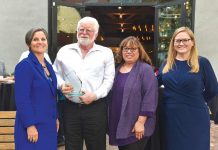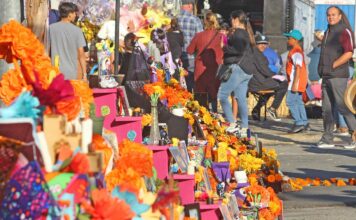This is the 17th consecutive year that Bay Area Mennonite
churches have sponsored The International Gift Faire, a unique
opportunity for local residents to make an impact on world poverty
while learning more about the folk arts of Africa, Asia and Latin
America.
This is the 17th consecutive year that Bay Area Mennonite churches have sponsored The International Gift Faire, a unique opportunity for local residents to make an impact on world poverty while learning more about the folk arts of Africa, Asia and Latin America.
It will be held Oct. 14 from 9am to 8pm and Oct. 15 from 10am to 4pm at Lincoln Glen Church Fellowship Hall, 2700 Booksin Avenue in San Jose.
The International Gift Faire features hundreds of unique gifts and home décor items in bamboo, wood, natural fibers and ceramics – things like baskets, ornaments, musical instruments, toys, rugs and brassware from 30 developing countries like Bangladesh, El Salvador, Thailand and the Philippines.
These handicrafts are imported by Ten Thousand Villages, a nonprofit marketing and job-creation program established in 1946 by the Mennonite Central Committee. Its mission is to create economic opportunities that help people in developing countries earn a decent and fair living, enabling them to afford improved health care, nutrition, housing and education.
All proceeds from the Gift Faire are donated to Ten Thousand Villages, which allows the purchase of more crafts from an increasing number of poor people. More than 200 volunteers operate the San Jose fair, which helps to eliminate the exploitative profits of middlemen. Last year, shoppers from Hollister to Palo Alto helped earn more than $60,000 for Ten Thousand Villages. For more information, call (408) 264-1662 or visit the Internet at www.internationalgiftfaire.com.
The Mennonites trace their origin to Anabaptism, a Reformation movement begun in Switzerland in the 16th century. The Anabaptists were persecuted by both Roman Catholics and other Protestants because of their distinctive beliefs: only adults could be baptized; they refused to take oaths of allegiance to governments, accepted only the Bible as authority, and refused to serve in the military.
Among the religious groups today which are descended from the Anabaptists are the Huttites, Amish and Mennonites (the largest group, named for Dutch Catholic priest Menno Simons who converted to the Anabaptist faith and helped lead it to prominence). Today there are about a half-million members of these groups in the United States, about a million worldwide.
A notable part of their faith relates to serving others. This is especially apparent in the functioning of the Mennonite Disaster Service. Mennonites have always helped each other: the famous barn-raising scene in the Harrison Ford movie “Witness” (although featuring Amish) is a good example, symbolizing “the love of Christ and the advantages of mutual community helpfulness.”
But in the in 1950’s, the Mennonites began to organize further and expand this mutual aid beyond their own membership. As a people of peace opposed to military participation, the Mennonites find disaster relief another opportunity to serve the nation as a whole. Each year more than 3,000 volunteers participate in post-disaster cleanup and repairs, at no charge to victims. The Mennonite Disaster Service is currently mobilizing volunteers to aid hurricane victims in the Gulf Coast area.
Chuck Flagg teaches English at Mt. Madonna High School. Write to him at P.O. Box 22365, Gilroy, Calif. 95021.










